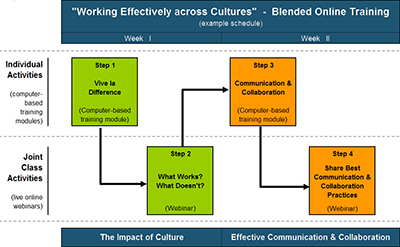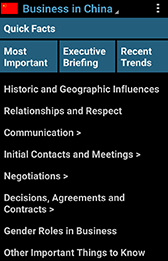Book Of The Quarter
Dragons at
Your Door
Video Of The Quarter
Understanding The Rise Of China
Quote Of The Quarter
of change blow,
some people
build walls
and others
build windmills
Leadership Crossroads
is a competent resource for
- Global Business Training & Coaching
- Global Negotiation Training and Assistance
- Global Project Management
- Organizational Learning and Development
across Cultures - Executive Coaching
Serving clients
world-wide since 2004
In Focus:
eLearning? Really? Must I?
How many online training events have you experienced? None? Seriously?
These days, eLearning is hard to avoid. Whether it is your company asking you to take a training, your brokerage telling you about new investment options, your industry association conducting a remote meeting, or your own desire to develop yourself and learn something new, some kind of online learning tool is usually involved in any of these activities, from YouTube videos to canned presentations, webinar software, or other online meeting tools. All of this comes under the umbrella of distance learning or ‘eLearning,’ the ‘e’ letting us know that computers are involved.
Problem is, experience lets most people expect online learning to be boring with a big B. There is little fun to be had when you watch a PowerPoint presentation on your computer, trying to follow a monotonous narrative while tempted to do something more fun, like checking your email or social media news. Newer online communication tools at least show you a video of the speaker, but that small talking head in the upper right corner of your screen hardly makes this much more exciting. Sure, classroom-style learning can be boring, too, but a lively trainer will make a difference here. But online?
My first e-learning experience as a facilitator came more than ten years ago, teaching a virtual class in an MBA program. Back then, online training was boring. Bandwidth was limited, download times were long, and tools for online education were poor. Accordingly, simple visuals plus (recorded or live) audio were all that eLearning had to offer. While people recognized that learning online had some advantages, like the option to access lectures and other materials repeatedly and at one’s own schedule and pace, the limitations that were inherent to those days’ technology still made this way of learning painful.
However, technology and tools made great progress since then, enabling far more complex approaches to remote teaching. For my part, I also learned over the years how to facilitate online learning in ways that are as rich and intense as any face-to-face training should be.
Personally, the strongest push came from a very large American client who insisted that we find a way to take a three-day training online that previously took place in-classroom. Their issue, common across large multinationals, was that the groups and teams to be trained were distributed across several countries and time zones. The company was that much not worried about flying a trainer around: bringing all of these learners to the same location was what they considered cost-prohibitive. Our answer was to employ blended online training, which typically includes offline elements (complex interactive lectures, reading, etc.), team assignments where learners collaborate in virtual teams, and virtual class meetings bringing everyone together online with an instructor. The concept worked extremely well and allowed training events that were simply impossible before. For instance, we had deliveries of this training that in some cases simultaneously included participants living and working in 12 different countries.
Allowing geographically distributed groups of learners is only one advantage of this type of training: timing can be much more flexible, too. Where possible, we try to structure such programs in ways that demand only 1-2 hours of learner time per day, a real benefit in today’s work environment as people can still handle much of their normal workload while continuing their personal development.
When a large European client asked for a series of face-to-face training events across several countries, we convinced them to integrate an online component, with the primary purpose of helping participants become more comfortable with online collaboration, a growing need in their daily interactions. Exploring how online meetings can be both effective and fun converted several of the participants from sceptics to enthusiasts!
Nowadays, eLearning can include video of whoever is speaking, switching automatically between all involved. Chat functions and drawing tools are ubiquitous and allow everyone to share opinions, question and comments whenever they want. Many other interactive elements, such as polls, multiple-choice forms, self-assessments, and more serve to add further depth to the learning experience. All of these options make it easy for facilitators to design online learning that frequently involves and engages all of the participants. In fact, eLearning events that do not include regular and frequent interaction across the whole group in my view should be banned altogether.
Because of all the technology changes and the resulting options to offer a much richer online training experience, I am convinced that more and more people will discover eLearning not as a cost-cutting tool, which it is not, but as a powerful option for effective people development. The next time you attend a boring online event, make sure to tell the facilitator that it does not have to be and challenge him/her to make it more interactive, productive and exciting. You deserve it!
This article is also available
in PDF format (requires Adobe Reader ).
Read an interview with Lothar Katz by Jan Daniel
How do you prepare for an international trip?
Which skills make you effective in global business?
Blended Online Training: Working Effectively across Cultures
This highly interactive online training includes individual self-paced learning and webinar-style exchanges of experience with the facilitator and others in the class. Check out our module preview to get an idea of how much fun online learning can be!

- Can be spread over as little as two days and as much as two weeks.
- Flexible schedules allow learners to get most of their normal work done.
- Online access from anywhere facilitates multicultural learning.
- Webinars can leverage client’s normal environment.
- Newsletter informs learners of next steps.
- Password-protected site provides self-paced modules, course information, and additional materials.
Please contact us if you would like to know more about this innovative online training.
International Business
Business Culture Guide
All 50 individual Country Sections from
Negotiating International Business are available online for free.
Download Country Section PDF files now.

Lothar Katz is the founder of Leadership Crossroads. He has helped many clients
achieve productive cooperation across cultures and drive business success on a global scale.
A seasoned global executive, he regularly interacted with employees,
customers, outsourcing partners, and third parties in numerous countries around the world.
Contact :
info@leadershipcrossroads.com
Leadership CrossroadsSM, 2016
Ten Tips for Doing Business in China
Our newsletter is a quarterly publication about all aspects of International and Cross-Cultural Business Management.
The 2Q 2016 issue is on the web at
www.leadershipcrossroads.com/news_0416.htm. Past issues can be found in our
newsletter archive.
If this issue has been forwarded to you, would you like to subscribe to it now?
If you are a current subscriber but you do not wish to receive this newsletter in future, simply send a blank e-mail to
unsubscribe@leadershipcrossroads.com.



